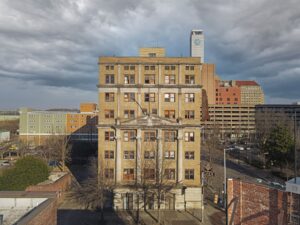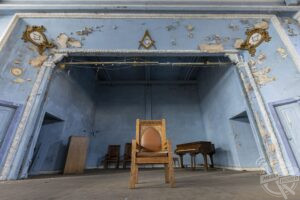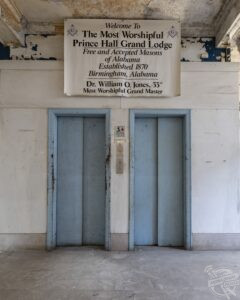By Aimee Braniff Cree
**EXCLUSIVE**
CONTROVERSIAL images show a “Coloured” only Masonic Lodge the black community was forced to establish after being banned from their local lodge due to racist Jim Crow laws in the US Deep South.
These images could be some of the last captured images of the historic building, once visited by legendary civil rights hero Martin Luther King Jnr and site of the anti-segregation Birmingham Campaign in May 1963, as it was announced that the Grand Lodge would be demolished and the Historic District Developers would be working together on a $29 million mixed-use building redevelopment.
One image shows the welcome sign displayed above the elevators, this sign proudly displays the history of the building and reinstates the important role it has played in the community in Alabama for over 100 years.
A harrowing image shows obituaries of former masons taped to the wall below a sign explaining that there will be a cost increase for patrons of the establishment from November 14th 1983.
An eerie image shows blow drying machines located on the ground floor of the building, these are what remains of one of the last business’ to occupy the building, Pattons Beauty Shop owned by Bernice Patton.
The outside of the Masonic Temple appears to be well preserved, a few windows are boarded up but it remains a striking building. It was completed debt free with donations mostly made up of nickels and dimes from Prince Hall Masons.

A captivating image depicts a pool table covered in debris from the crumbling roof, that pool table was once played on by Martin Luther King, a piece of history that will never be captured again.
It was in 1963, while in Birmingham to recruit nonviolent protestors for the Birmingham Campaign that Martin Luther King, Jr. stopped by the Masonic Temple Building for a game of billiards, he was joined for the game by former Grand Master and Endowment Secretary S. J. Bennett.
During the Birmingham Campaign, Arthur Shores represented Martin Luther King, Jr. and Fred Shuttlesworth, and the other demonstrators who were arrested. He became a leader in the 1963 efforts to integrate Birmingham City Schools and later appealed to nullify the arrests of 3,000 peaceful protestors during the Birmingham Campaign before the Supreme Court.
His involvement in the Birmingham Campaign came with a hefty price as Shores’ home in Smithfield was firebombed twice. His wife suffered a concussion in the second incident.
The neighborhood was nicknamed “Dynamite Hill” following a series of bombings. This set off rioting against police in the neighborhood and one person lost their life.
The violence came to a head on September 15, 1963, when members of the KKK bombed the Sixteenth Street Baptist Church and killed four young girls.
What began as peaceful demonstrations of the Birmingham Campaign were met with violence, tear gas, and police dogs. The events were a watershed moment in the civil rights movement, making front-page news around the world.

These history-preserving images were captured by Urban Photographer Leland Kent, also known as Abandoned Southeast.
“In 1867, two years after the Civil War, what became known as “Colored” Masonry came into existence in Alabama.” said Leland in his blog.
“By 1869, there were between eight and ten traditionally recognized lodges in the state. These lodges were operated under charters issued by the states of Ohio, Tennessee, and Missouri.
“In September 1870, the Masters, Wardens, and legal representatives of the subordinate lodges gathered at the Colored Masonic Hall in Mobile to create a Colored Grand Lodge known as the Independent Most Worshipful Grand Lodge, Ancient Free and Accepted Masons of Alabama.
“In 1874, another Colored Grand Lodge was formed and known as the National Compact Grand Lodge.
“The two Grand Lodges operated independently in Alabama until a convention in August 1878 brought them together to form the present-day Grand Lodge of Alabama, adopting the name Most Worshipful Grand Lodge, F. & A. M. of Alabama.
“After 1900, as Birmingham surged forward to become Alabama’s largest city, the Grand Lodge was eager to build a state headquarters downtown.
“In the early 20th century, there was no such thing as a Black business district in the South. Jim Crow laws authorizing the separation of races excluded Blacks from White-owned businesses across Birmingham.
“This forced African–American businesses to move downtown around what would become the 4th Avenue Business District.
“For decades, the area was a booming social hub complete with packed theaters, restaurants, jazz clubs, and vibrant city life.

“The Masonic Temple was designed by one of the first accredited African–American architect firms, Robert Taylor and Louis Persley.
“In 1922, construction on the Most Worshipful Prince Hall Grand Lodge, F. & A. M. of Alabama Temple Building began at 1630 Fourth Avenue North.
“The seven-story Mannerist-influenced, Renaissance Revival-style building was constructed by the Windham Brothers Construction Company.
“The entire construction cost of $658,000 was paid by contributions, therefore zero debt was accrued by the Masons.
“The Masonic Temple Building relies on annual contributions from the Prince Hall Free Masons to pay for maintenance and upkeep.
“Upon completion, the Masonic Temple Building was the largest and best-equipped state-of-the-art luxurious building built and paid for by Negroes in the entire world.
“In addition to housing the state headquarters for Prince Hall Masons and the Order of the Eastern Star, the Temple Building served as the exclusive social and cultural center for the African–American community for many years.

“In time, the Masonic Temple would figure in the civil rights struggle as it sheltered the offices of the NAACP, the Southern Negro Youth Congress, the Right to Vote Club, and the Jefferson County Negro Democratic Youth League.
“In recent decades, with the decline of Freemasonry, a building that once figured prominently in a vibrant Black urban life has faced a sort of functional obsolescence.
“The Prince Hall Grand Lodge still owns the building, but the grand auditorium hasn’t been used for meetings since the early 2000s.
“After serving the community for more than 80 years, the Masonic Temple Building was closed in 2011 due to maintenance costs.
“Unfortunately, the building has fallen into a state of disrepair white sitting dormant. Several windows remain boarded up, but the future seems bright for the blighted structure.”
Read more on Lelands Blog: https://abandonedsoutheast.
ENDS









